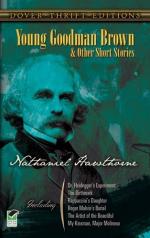|
This section contains 211 words (approx. 1 page at 400 words per page) |

|
Young Goodman Brown Summary & Study Guide Description
Young Goodman Brown Summary & Study Guide includes comprehensive information and analysis to help you understand the book. This study guide contains the following sections:
This detailed literature summary also contains Bibliography and a Free Quiz on Young Goodman Brown by Nathaniel Hawthorne.
"Young Goodman Brown," written in 1835 by Nathaniel Hawthorne, is known for being one of literature's most gripping portrayals of seventeenth-century Puritan society. The tale first appeared in the April issue of New England Magazine and was later included in Hawthorne's popular short story collection, Mosses from an Old Manse, in 1846.
"Young Goodman Brown" tells the tale of a young Puritan man drawn into a covenant with the Devil. Brown's illusions about the goodness of his society are crushed when he discovers that many of his fellow townspeople, including religious leaders and his wife, are attending a Black Mass. At the end of the story, it is not clear whether Brown's experience was nightmare or reality, but the results are nonetheless the same. Brown is unable to forgive the possibility of evil in his loved ones and as a result spends the rest of his life in desperate loneliness and gloom.
Though a work of fiction, "Young Goodman Brown" is widely considered to be one of the most effective literary works to address the hysteria surrounding the Salem Witch Trials of 1692. Hawthorne is also remembered for helping to establish the short story as a respected form of literature and as a proponent of instilling morals and lessons into his writing.
Read more from the Study Guide
|
This section contains 211 words (approx. 1 page at 400 words per page) |

|



